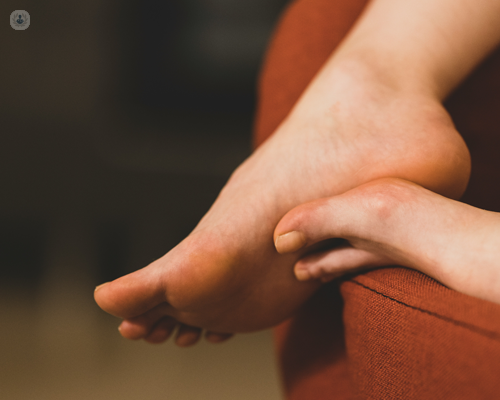Hallux rigidus in-depth
Autore:Mr Haroon Majeed, leading consultant orthopaedic foot and ankle surgeon in Greater Manchester and Wilmslow, provides a detailed insight to hallux rigidus, also known as big toe arthritis.

What is hallux rigidus?
Hallux rigidus is a type of osteoarthritis affecting the joint at the base of the big toe. This condition leads to wear and tear in the joint, often due to overuse from activities such as sports, squatting, or previous injuries like fractures. It can also develop as part of other arthritic conditions such as rheumatoid arthritis, inflammatory arthritis or gout.
What are the symptoms?
Common symptoms of hallux rigidus include pain during movement of the big toe, stiffness, swelling, the presence of a bony bump and difficulty in wearing shoes, particularly those with heels.
What treatment options are available for hallux rigidus?
For individuals with mild and non-painful arthritis, treatment may not be necessary. However, if the joint is painful, certain measures can help manage the condition:
- Wearing flat, well-fitting shoes with a wider toe box and rigid soles, as well as shoes with laces or adjustable straps.
- Taking pain relief medications.
- In early stages, a steroid injection may help control the pain.
If the pain worsens and affects daily activities, and advanced arthritis is confirmed through X-rays, surgery may be necessary to address the arthritic joint.
What is involved in surgery for hallux rigidus?
Surgery for hallux rigidus aims to alleviate pain, straighten the big toe and improve function in daily life, though it does not cure arthritis. There are different surgical options:
- Cheilectomy: Removal of extra bone around the joint to improve pain and function, used in less severe cases.
- Fusion (Arthrodesis): The worn-out joint surfaces are fused together using small screws or metal plates, commonly done for more definitive treatment.
- Joint replacement: The joint is replaced with a silicon implant, though this is less common.
The surgery is usually performed as a day case under general or spinal anaesthetic, with regional local anaesthetic often used for post-surgery pain relief. The procedure involves an incision over the big toe joint, removal of the worn-out joint surfaces, and fixing the joint in a straight position. The wound is closed with either removable or absorbable sutures, and the foot is bandaged. Patients are provided with a wooden-sole shoe and crutches for mobilisation for about six weeks.
What is the recovery process like?
In the first few days after surgery, it’s recommended to elevate the foot above heart level to reduce swelling. Oral pain relief medications are usually needed to control pain. Patients are typically reviewed two weeks after surgery to check the wound and remove sutures. At six weeks, an X-ray is performed to assess healing, and patients can generally start using their own shoes. However, additional time with a wooden-sole shoe may be required if healing is insufficient.
For left foot surgery, driving an automatic car may be possible once the wound has healed. For right foot surgery, most individuals can start driving around eight weeks post-surgery. Air travel is not recommended within six weeks, and returning to office work may be possible around six weeks, depending on the need for driving. Manual work is generally not recommended until up to 12 weeks post-surgery.
What are the differences between fusion and replacement?
Both fusion and replacement surgeries aim to relieve pain from the arthritic joint:
Fusion: The joint is fixed in one position, losing its movement. This is more commonly performed and suitable for individuals with physically demanding jobs.
Replacement: The joint maintains its range of movement. This option is less commonly available and usually reserved for those with less physical demand.
Both procedures generally result in excellent pain relief and improved comfort in wearing shoes. Metalwork from fusion is not routinely removed unless it causes issues. Silicone implants from replacement surgeries have a high longevity, lasting over ten years in more than 90 per cent of cases.
What are the potential complications after surgery?
Possible complications include:
- infection;
- wound problems;
- bleeding;
- blood clots;
- delayed or non-healing of the bone;
- ongoing pain;
- stiffness;
- numbness around the scar;
- chronic regional pain syndrome, and;
- issues with metalwork that may require removal.
These complications occur in a small percentage of cases but the risk increases with certain medical conditions and long-term medication use.
If you require expert treatment for hallux rigidus, arrange a consultation with Mr Majeed via his Top Doctors profile.


